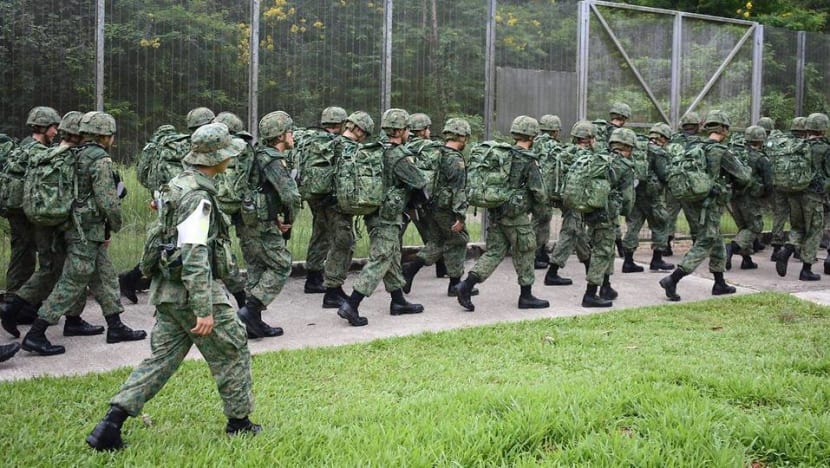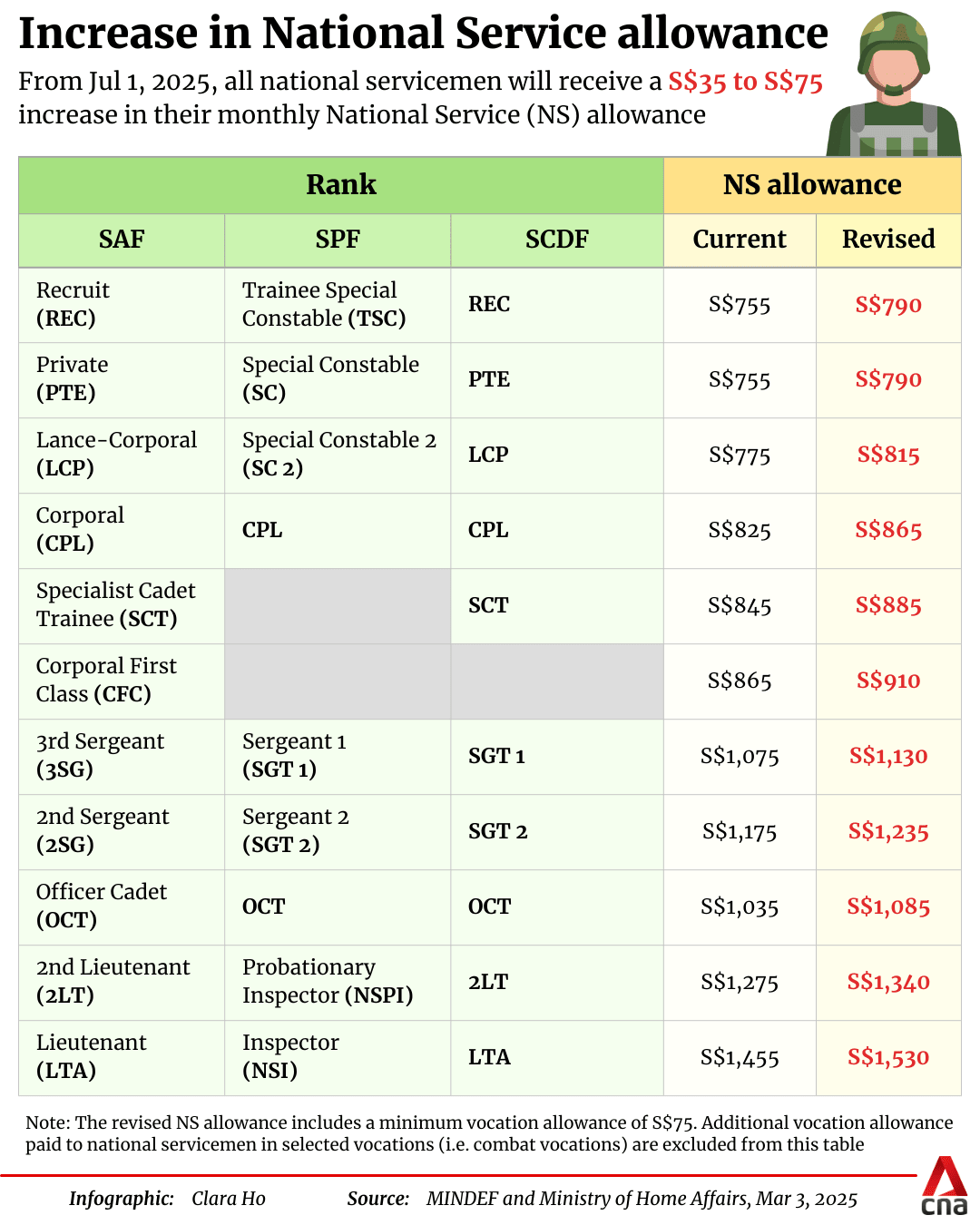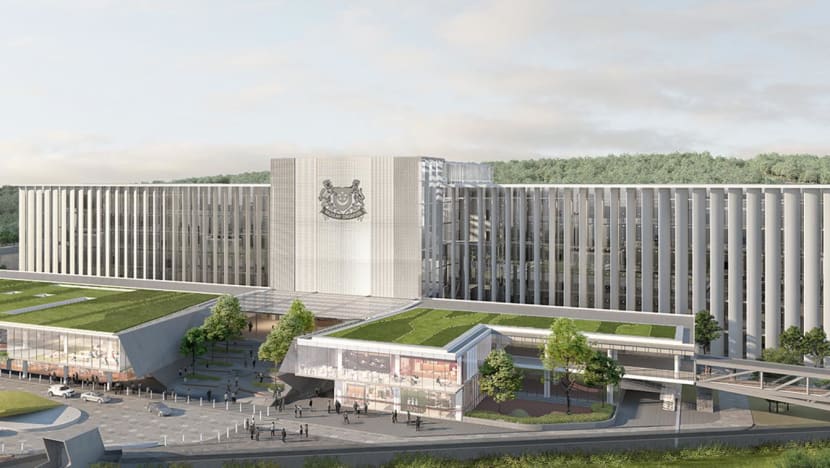NSF allowance to increase by 4% to 5% for most Singapore servicemen
Full-time national servicemen will get S$35 to S$75 more in their monthly allowances.

Soldiers on a route march in Singapore. (Photo: Facebook/Basic Military Training Centre)

This audio is generated by an AI tool.
SINGAPORE: All full-time national servicemen (NSFs) in the Singapore Armed Forces (SAF), Singapore Police Force (SPF) and Singapore Civil Defence Force (SCDF) will receive an increment of S$35 to S$75 (US$26 to US$56) in their monthly allowances, starting from Jul 1.
This translates to an increase of about 4 to 5 per cent for most servicemen.
The allowance supports NSFs' personal upkeep and recognises their service, and is regularly reviewed to ensure it remains adequate, Senior Minister of State Heng Chee How said on Monday (Mar 3) during the Ministry of Defence's (MINDEF) Budget debate in parliament.
This will be the fourth adjustment to allowances over the last 10 years, the ministry said separately.
The previous increase was in July 2023, when allowances were raised by S$125 to S$200, depending on the serviceman’s rank and vocation.
With the latest revision, an NSF holding the rank of recruit or trainee will receive an allowance of S$790, up from the current S$755.
For an SAF NSF naval diver, SPF NSF police tactical trooper or SCDF NSF firefighter holding the rank of corporal, the monthly allowance will increase to S$1,290 from S$1,250.

REDESIGNING ROLES
The SAF has also been reviewing its medical classification system to move away from a binary combat-fit or non-combat fit model.
Mr Heng first announced the shift during his ministry's budget debate in 2021.
"The new system will assess each serviceman on a more granular scale, allowing better characterisation of their medical fitness and functional capacity so that they can be better matched to more operationally effective roles," he said on Monday.
"This is a fundamental change that we are carefully studying and determining how to implement."
Over the past two years, the SAF has been conducting functional assessments for pre-enlistees with selected orthopaedic conditions, in addition to the standard medical screening.
Since 2022, about 300 pre-enlistees have undergone selected functional assessments and 230 - or two-thirds of them - were able to contribute more effectively over a wider range of roles, Mr Heng said.
The SAF has also continued to leverage technology and redesign jobs to expand servicemen's deployment opportunities.
Since 2021, it redesigned 2,000 roles across 25 vocations, such as combat medics, infantry carrier vehicle operators and military police.
More than 1,000 NSFs have also been deployed in a wider range of operational roles to date, MINDEF added.
CMPB TO OPEN PROGRESSIVELY
As part of improving the NS experience, the new Central Manpower Base (CMPB), located opposite Cashew MRT station, will progressively open in phases from May 2025.
Mr Heng previously announced the new facility during last year's Budget debate. It will replace the current one at Depot Road.
The new CMPB will serve as an integrated "one-stop" service centre for NS administration. This includes completing medical screenings, attending NS fitness activities at the all-weather fitness conditioning centre and purchasing NS necessities, said Mr Heng.

The new CMPB will also house the SAF's second regional health hub - with the first being at Kranji Camp III.
Spanning two levels, the CMPB hub will consolidate key healthcare facilities into one location, said Mr Heng.
"Today, a pre-enlistee with pre-existing medical conditions will have to visit multiple locations on different days for his medical classification test and specialist reviews.
"At the (regional health hub), which will come up at the new CMPB, this pre-enlistee will be able to complete his medical assessments in a single visit, with specialist appointments scheduled on the same day."
There will also be an improved queue management system to reduce waiting times, he added.
"By streamlining these medical processes, the hub is expected to serve around 200 servicemen daily, ensuring prompt and comprehensive healthcare support throughout their NS journey."
Meanwhile, the public can access exercise facilities at the new CMPB, such as an outdoor running path, fitness zone and football field.
The public can also enjoy amenities such as a childcare centre, a cafe and a food court.
MINDEF will also build a new SAFRA clubhouse - the largest yet - in the Bayshore area, with direct access to an MRT station.
"We plan for SAFRA Bayshore to be ready in a few years' time and to replace our oldest clubhouse at SAFRA Tampines, built in 1988," Senior Minister of State for Defence Zaqy Mohamad said.
SAFRA was formed in 1972 to improve camaraderie and boost morale among servicemen. At present, there are seven SAFRA clubhouses across Singapore that provide servicemen and their families with affordable recreational facilities and lifestyle offerings, Mr Zaqy added.
SUSTAINABLE SAF
Meanwhile, a solar farm will be built within Sembawang Air Base this year, to help to offset MINDEF's energy demands and as part of an effort to meet national targets under the Singapore Green Plan 2030.
The plan aims to advance Singapore's national agenda on sustainable development.
In 2021, MINDEF had committed to deploy more solar panels in SAF camps and bases, to achieve a target of 50 megawatt peak of solar capacity by 2025, equivalent to the annual electricity consumption of 13,000 four-room Housing Board flats.
The solar farm within Sembawang Air Base will generate energy equivalent to the electricity consumed by 4,700 four-room HDB flats in a year, said Mr Zaqy.
This will lead to cost savings of approximately S$1.9 million annually and bring the ministry closer to achieving its emissions reduction target for 2030, he added.
The location for the solar panels was "carefully selected" to ensure that SAF's operational effectiveness would not be affected, he said. This included detailed studies to ensure the glare from the panels would not pose a danger to military aircraft.
The panels will be installed on roughly 7ha of land as well as on rooftops of selected buildings within Sembawang Air Base. The energy generated will be channelled to Sembawang Air Base and the national grid, MINDEF said separately.

















